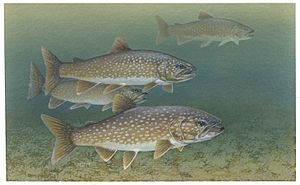Lake trout facts for kids
The Lake trout (scientific name: Salvelinus namaycush) is a cool fish that lives in lakes across northern North America. Even though it's called a "trout," it's actually part of the char family, which is a close relative.
These fish are usually dark gray or olive green and have light spots on their sides. You can easily spot them by their deeply forked tail. Lake trout are super tough and have adapted well to the very cold arctic and boreal (northern forest) areas.
Contents
What They Eat and How Long They Live
Lake trout are not picky eaters! They will eat almost anything they can find. They can even eat other fish that are half their own size. What's amazing is that they can go for a long time without food if they need to.
These fish can live a very long time, usually between 25 and 40 years. Imagine a fish living longer than your pet!
Reproduction and Eggs
Lake trout are very good at having babies. They spawn (lay eggs) every year for about eight to ten years in a row. A female lake trout can produce a lot of eggs. For every kilogram she weighs, she can lay about 1,000 eggs!
Size and Other Names
Lake trout can get really big! The largest one ever caught was in Canada and weighed an incredible 121 pounds (about 55 kilograms). That's heavier than many kids!
People call Lake trout by many different names, depending on where they are. Some common names include mackinaw, lake char (or charr), touladi, togue, and grey trout. If you're in Lake Superior, you might hear them called siscowet, paperbelly, or lean.
Lake trout are important for two main reasons. They are popular with people who love to fish for sport, and they are also caught and eaten as food fish.
Images for kids
See also
 In Spanish: Salvelinus namaycush para niños
In Spanish: Salvelinus namaycush para niños





